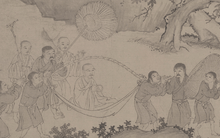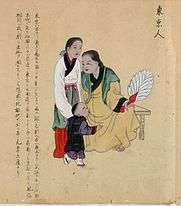Vietnamese clothing



Vietnamese clothing refers to the traditional clothes worn in Vietnam.
History
Chinese style clothing was forced on Vietnamese people by the Nguyễn dynasty.[1][2][3][4][5][6] Trousers have been adopted by White H'mong.[7] The trousers replaced the traditional skirts of the females of the White Hmong.[8] The tunics and trouser clothing of the Han Chinese on the Ming tradition was worn by the Vietnamese. The Ao Dai was created when tucks which were close fitting and compact were added in the 1920s to this Chinese style.[9] Trousers and tunics on the Chinese pattern in 1774 were ordered by the Vo Vuong Emperor to replace the sarong type Vietnamese clothing.[10] The Chinese clothing in the form of trousers and tunic were mandated by the Vietnamese Nguyen government. It was up to the 1920s in Vietnam's north area in isolated hamlets wear skirts were worn.[11] The Chinese Ming dynasty, Tang dynasty, and Han dynasty clothing was ordered to be adopted by Vietnamese military and bureaucrats by the Nguyen Lord Nguyễn Phúc Khoát (Nguyen The Tong).[12]
Examples of garments
- Áo dài - the typical Vietnamese formal girl's dress
- Áo giao lĩnh - cross-collared robe worn before the Nguyen dynasty.
- Áo tứ thân - a four-piece woman's dress, áo ngũ thân in 5-piece form.
- Yếm - woman's undergarment, similar to Chinese dù dōu.
- Áo bà ba - rural two-piece ensemble for men and women[13]
- áo gấm - formal brocade tunic for government receptions, or áo the for the man in weddings.
- Headware includes Đinh Tự, Phốc Đầu, the standard conical nón lá, and "lampshade" nón quai thao.
- Áo tràng Phật tử - typically shortened to "áo tràng" it is a robe worn by Upāsaka and Upāsikā in Vietnamese Buddhist temples. Typically light blue but can be found in brown and is similar to the ones worn by Vietnamese Buddhist monastics in regards to the trademark collar similar to the áo dài but without the sleeves with hidden pockets. While there are matching pants they are not a required part of the outfit for laity. A similar version can be found in Cao Đài temples.
Clothing associated with the Vietnam war include: "black pyjamas", dép lốp (rubber sandals), the rural khăn rằn scarf.
20th Century
From the twentieth century onward Vietnamese people have also worn clothing that is popular internationally. The Áo dài was briefly banned after the fall of Saigon but made a resurgence.[14] Now it is worn in white by high school girls in Vietnam. It is also worn by receptionists and secretaries. Styles differ in northern and southern Vietnam.[15] The current formal national dress is the áo dài for women, suits or áo the for men.
References
- ↑ Alexander Woodside (1971). Vietnam and the Chinese Model: A Comparative Study of Vietnamese and Chinese Government in the First Half of the Nineteenth Century. Harvard Univ Asia Center. pp. 134–. ISBN 978-0-674-93721-5.
- ↑ Globalization: A View by Vietnamese Consumers Through Wedding Windows. ProQuest. 2008. pp. 34–. ISBN 978-0-549-68091-8.
- ↑ http://angelasancartier.net/ao-dai-vietnams-national-dress
- ↑ http://beyondvictoriana.com/2010/03/14/beyond-victoriana-18-transcultural-tradition-of-the-vietnamese-ao-dai/
- ↑ http://fashion-history.lovetoknow.com/clothing-types-styles/ao-dai
- ↑ http://www.tor.com/2010/10/20/ao-dai-and-i-steampunk-essay/
- ↑ Vietnam. Michelin Travel Publications. 2002. p. 200.
- ↑ Gary Yia Lee; Nicholas Tapp (16 September 2010). Culture and Customs of the Hmong. ABC-CLIO. pp. 138–. ISBN 978-0-313-34527-2.
- ↑ Anthony Reid (2 June 2015). A History of Southeast Asia: Critical Crossroads. John Wiley & Sons. pp. 285–. ISBN 978-0-631-17961-0.
- ↑ Anthony Reid (9 May 1990). Southeast Asia in the Age of Commerce, 1450-1680: The Lands Below the Winds. Yale University Press. pp. 90–. ISBN 978-0-300-04750-9.
- ↑ A. Terry Rambo (2005). Searching for Vietnam: Selected Writings on Vietnamese Culture and Society. Kyoto University Press. p. 64. ISBN 978-1-920901-05-9.
- ↑ Jayne Werner; John K. Whitmore; George Dutton (21 August 2012). Sources of Vietnamese Tradition. Columbia University Press. pp. 295–. ISBN 978-0-231-51110-0.
- ↑ Saigon's Edge: On the Margins of Ho Chi Minh City - Page 56 Erik Harms - 2011 "She then left the room to change out of her áo Ba Ba into her everyday home clothes, which did not look like peasant clothes at all. In Hóc Môn, traders who sell goods in the city don “peasant clothing” for their trips to the city and change back "
- ↑ Saigon: A History - Page 202 Nghia M. Vo - 2011 "The new government banned the wearing of the traditional áo dài. Their income from sewing áo dài suddenly plummeted, forcing them to sell everything to survive: refrigerator, radio, food and clothing. Only after the ban was lifted ten years later .."
- ↑ Modernity and Re-Enchantment: Religion in Post-Revolutionary Vietnam - Page 157 Philip Taylor - 2007 "The contemporary versions of Áo dài are of considerable sociological interest as they represent regional variations, as well as age and gender arrangements (men rarely wear them nowadays and usually dress in Western-style suits)."